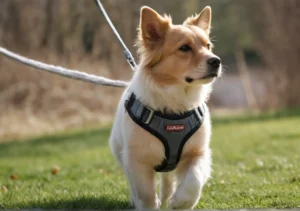Some trainers swear by them and claim they still have happy and healthy pets. But do they work when trying to stop a dog from running away?
Shock collars, in the right hands, are an effective tool for accelerating training and preventing your dog from running away. However, many corrective tools can be harmful and even backfire when misused. Whether it will work will depend on the dog and your skill in using this tool.
Whatever the case, I advise only using an e-collar with a trainer. They can be helpful tools but can also be easily abused if you don’t know what you’re doing.

Do Shock Collar Work on Dogs for Running Away?
While it is simple to purchase a shock collar, you cannot simply put it on and press the button when the dog is racing away. To utilize a shock collar correctly, you must have some knowledge and skill.
It takes a lot more effort on your part to understand how to condition an appropriate reaction than it does on the dog. As a result, if you lack the knowledge to educate your dog, the effects may be harmful.
A zap won’t necessarily stop an overstimulated dog already on the run, especially if they are chasing something unless the pain is so severe that it can’t run anymore.
The intensity of a shock collar can be adjusted, but the ideal setting isn’t necessarily the highest. Choosing the best collar for dogs that run away often means finding one that uses both sound and vibration cues, providing a tiered approach before resorting to the shock feature.
There are numerous E-collars, some of which are more effective than others. We’ve mentioned them in our dog collar guide. The goal of proper low-level E-collar training is not to shock the dog. It’s all about pairing with a positive and making it clear what is expected of the dog.
Once correctly taught, it functions as an invisible leash, allowing you to speak or shout to your dog up to half a mile away.
Before introducing it to your dog, please conduct a thorough study and learn the genuine usefulness of an E-collar.
Why Shock Collars May Not Work for Running Dogs
Because it is an aversive method, it must be executed with extreme precision. When you tell your dog not to do something, they better understand what you mean. Otherwise, your punishment will be ineffective.
The issue with them is that they can backfire if employed incorrectly. Even though they emit a gentle beep, they are still considered aversives and can cause problems.
I propose you use and experiment with other methods of training recall before resorting to shock collars.
Not only will this avoid many possible problems, but it will also help your dog develop a good recall without needing a tool. You don’t want a dog who will only respond to you if they are wearing a collar.
Shock collars are not magical and should only be used after professional training or instruction. Even if e-collars are practical, there is a high possibility of an adverse reaction.
The main issue with employing punishment as a training strategy is that it does not actually teach your dog what to do. If the dog enjoys running away, why not teach him that returning to you is more enjoyable?

Some dogs don’t mind shock collars, while others may experience trauma. When you use aversives, you take that risk. There are many static shock collars out there, but it should be your last resort.
It is ultimately up to you to make that decision. No matter how light it appears, there are safer and more beneficial alternatives to using a shock collar.
How Do You Keep a Dog From Running Away?
The most effective way is not to let it happen. Wrap the leash around your wrist or get a leash that clips to your belt buckle when walking your dog. Instead of a collar, use a harness.
Next, focus on your dog’s recall so that he comes to you in the face of any distraction, even the urge to flee. Whistle training is one technique that can be used for recall.
To teach a dog with a whistle, follow these steps: 1) whistle, 2) say the command, and 3) treat the dog when they perform the command. Do this a dozen times daily, and your dog will learn to anticipate the command following that specific whistle tone. You can then abandon your command and merely utilize the whistle.
Another practical tip is to invest in smart collars equipped with LED lights. These not only make your dog visible during nighttime but can also act as a deterrent for any potential chase triggers like nocturnal animals.
When practicing recall, try not to approach your dog. If you walk in the same direction as your dog, they are less likely to come to you. If your dog is toy motivated, have a special toy you only play with when he returns.
A great way to keep your dog from running away is to teach your dog to STAY. There are various methods for teaching a dog the “stay command.” Here’s an excellent video that can teach you how to do it:
Additionally, try to work with your dog on boundaries. Teach them only to cross the street once you permit them. Stop and wait for them to sit every time you take them outside, make eye contact with them at the entrance, and only let them out when they’re quiet.
You can begin by closing the door and gradually increasing the difficulty by opening the door and even walking outside while your dog remains inside until freed.
Ways to Keep Your Dog in House
Is your dog escaping when the door is left open? Keep the door closed at all times, or allow them to get close if they are leashed until you can train them. You can also kennel or gate your dog in another room.
You can employ impulse control and management techniques. Make an air-lock around the front door with baby gates, and practice “wait” at the door, leashed and unleashed. Begin with a closed door to the outside and heavily reinforce this behavior.
Tethering is another option. Keep a leash on the dog and tether it to yourself or a stationary object in or around the house that they can’t pull over. Use it with a harness so they don’t hurt themselves if they run against the end of the leash.
What Dog Breeds Run Away the Most?
Dogs bred to work with people are typically more obedient and, naturally, stick closer to their owners. Breeds created to function without the assistance of humans usually do not flee as naturally.
With that in mind, Spitz, hound, and terrier breeds are more inclined to run off-leash, making it more challenging to train them to stay close.
Huskies are one example of these breeds. They do nothing except run and are always in need of exercise and stimulation. They’re an independent breed with a strong prey drive, so keep an eye on them if you’re out with one.
On the other hand, toy breeds, herding, sports, and working types run away the least since they are easier to train and naturally keep closer together.
Even though each dog is unique and their temperaments vary, those are actual trends within breed groups.
In the quest to ensure our dogs’ safety, remember that every tool, including shock collars, has its place. It’s about understanding your dog’s unique needs and making the best choices for their well-being.
FAQs
Are Shock Collars Illegal in Some States?
Shock collars are legal in all of the United States. Some bills in the process may get passed that prohibit the sale or distribution of any electric shock dog collar. However, as of now, shock collars are legal in the US.
Can a shock collar kill a dog?
The typical shock collar (e-collar) that produces a mild beep on the dog’s neck should never be able to kill a dog or even hurt him. Most dog shock collars today are far from inflicting physical pain. Mental pain, possibly, but not physical.
Can a shock collar stop a dog from chasing a car?
A skillful trainer can use an e-collar to stop a dog from chasing a car. For an amateur, though, it’s a risk. Not only could a high-prey drive dog start running even faster, but it could also get hurt physically. The alternative solution is to stop this behavior before it happens.
Alex, a passionate animal lover, has experience in training and understanding animal behavior. As a proud pet parent to two dogs and three cats, he founded AnimalReport.net to share insights from animal experts and expand his knowledge of the animal kingdom.




